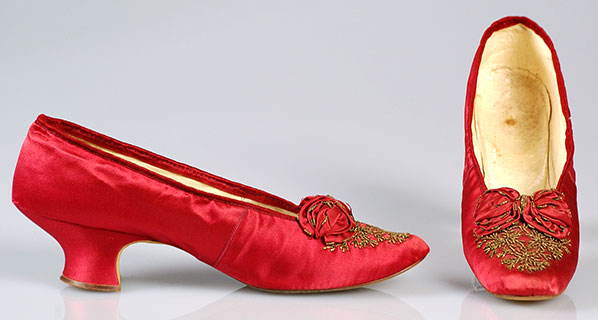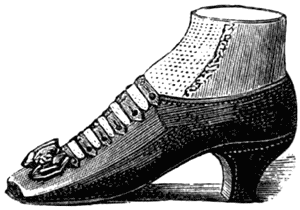How to Dress Victorian: Shoes
Have you ever noticed how minuscule and narrow antique Victorian shoes appear? According to a 1870s ladies magazine, “The foot is one of the chief points by which a woman’s social position is judged. If the feet are small, well-shod, and prettily used in walking, they add an additional charm to the appearance, and are an indication of high standing and … of gentle birth.” Assessments such as this led to the collective desire to make the foot look as small as possible, and, for that reason, to crush them into boots and shoes a size, or even two sizes, smaller than that of the foot itself. |
||||
The Feet: Victorian Shoes, Stockings, Boots (1870s) |
||||
 |
||||
Silk evening slippers, 1875–85 [Image credit: Brooklyn Museum Costume Collection at The Metropolitan Museum of Art, Gift of the Brooklyn Museum, 2009; Gift of Edith Gardiner, 1926. Accession Number: 2009.300.4102a, b. Metropolitan Museum of Art - Gallery Images, www.metmuseum.org] |
||||
 |
||||
Walking Shoe— This kid shoe is worn with an embroidered stocking. The front is barred across with straps that are fastened at the side with buttons. There is a bow on the toe. |
||||
 |
||||
The Oriental Shoe— This shoe is barred across the instep with three straps, each ornamented with a bow. This Victorian shoe has a Louis XV heel. |
||||
 |
||||
Black Satin Boot for the house, laced upon the side, and fastened up the front with straps to show the fancy stocking underneath. |
||||
|
||||
 |
||||
| Ladies' riding boot with spur; cord and tassels ornament it. | ||||
|
||||
| High-heeled Walking Shoes | ||||
 |
||||
| Lady's Bedroom Slipper | ||||
The slipper illustrated above is found to be convenient during illness, and for the morning walk to and from the bathroom, is made of grey linen cloth, embroidered in buttonhole stitch with red cotton, and in point russe with blue. The raised spots are knotted stitch-work, with white embroidery cotton. The slipper has a felt sole and cork sock. Round the edge of the slipper is a ruching of red worsted braid and a bow in the middle. |
||||
 |
||||
| Lady's Embroidered Slipper | ||||
 |
||||
| Embroidered Morning Slipper | ||||
 |
||||
| Lady's Bedroom Slipper | ||||
This is a Victorian slipper of white Berlin wool in double crochet. Round the heel is a row of chain stitches in dark red. Round the front of the slipper is a shell-shaped ruching of red ribbon. |
||||
 |
||||
| Embroidered Bathing Slipper | ||||
 |
||||
| Drilling Bathing Slipper | ||||
|
||||
| Stockings | ||||
Stockings were as carefully chosen as boots or shoes; as regards fit, neither too tight nor too loose. Tight boots and tight stockings wore out very quickly. If too loose, they were uncomfortable. For winter wear, stockings were woolen or merino. Home-knitted stockings wore much better than any that could be bought. Period ladies’ magazines gave instructions for stockings, and an account of the best materials to use; they also recommended that stockings should be changed at least twice a week. For summer wear, Lisle thread stockings ranked next in order to silk, but the latter were expensive. |
||||








